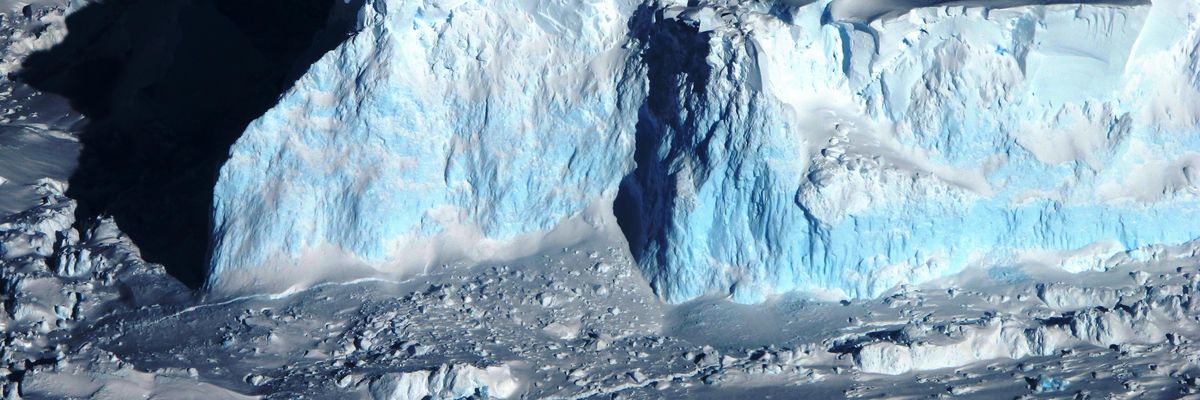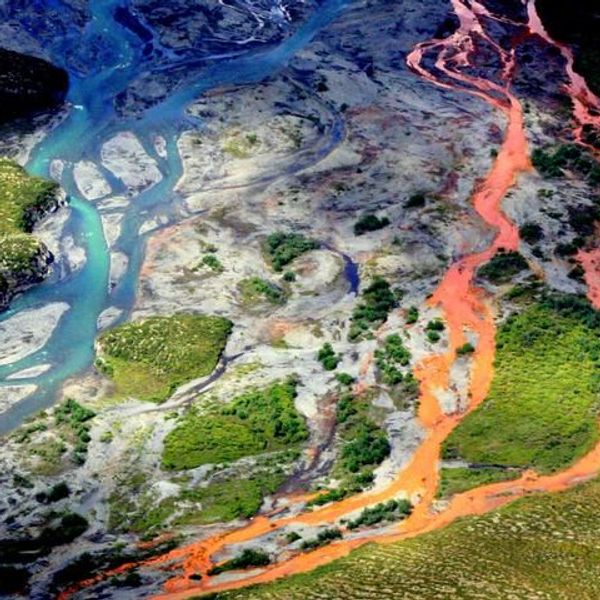
The Thwaites Glacier in Antarctica has been called one of the world's most "dangerous" glaciers because of the significant sea level rise its melting would cause. (Photo: Stuart Rankin/Flickr/cc)
City-Sized 1,000-Foot Deep Cavity Found in Glacier, Warns NASA, Signaling 'Rapid Decay' of Antarctic Ice
If the Thwaites Glacier were to eventually collapse into the ocean, scientists fear, "it might be more than a scientific curiosity. Indeed, it might be the kind of event that changes the course of civilization."
NASA scientists were startled when a recent exploratory mission revealed a huge and rapidly-growing cavity on the underside of one of Antaractica's glaciers--signaling that the ice mass has been melting much faster than experts realized.
The cavity is two-thirds the size of Manhattan--large enough to have contained about 14 billion tons of ice before it melted, according to a report that was published in Science Advances on Thursday.
Much of that ice disappeared at an "explosive rate," scientists reported--likely melting only in the last three years.
"The size of a cavity under a glacier plays an important role in melting," lead author Pietro Milillo said in a statement. "As more heat and water get under the glacier, it melts faster."
The agency's Jet Propulsion Laboratory used ice-penetrating radar to explore the area beneath the Thwaites Glacier in West Antarctica, often called "one of the world's most dangerous glaciers" because its melting could significantly contribute to sea level rise. Scientists expected to find some relatively small gaps between the glacier and bedrock, but were unsettled by the 1,000-foot deep cavity the mission revealed.
\u201cA giant, growing cavern two-thirds the area of Manhattan is contributing to the rapid melting of Antarctica\u2019s Thwaites Glacier. Findings highlight the need for detailed observations of Antarctic glaciers' undersides in calculating future sea level rise. https://t.co/fNfgACQNav\u201d— NASA Climate (@NASA Climate) 1548885244
\u201cCool cool, scientists just discovered a giant cavity amounting to 14 billion tons of missing ice beneath Antarctica's most imperiled glacier https://t.co/QyUBGINoCL\u201d— Maddie Stone (@Maddie Stone) 1548900377
As Common Dreams has reported, the study follows numerous recent scientific reports showing that ice in Antarctica is melting at a much faster rate than previously thought--as oceans warm more rapidly as well.
The melting of the Thwaites Glacier, which is the approximately the size of Florida, is already behind about four percent of global sea rise, according to the Jet Propulsion Laboratory. The disappearance of the ice mass would cause sea levels to rise by about two feet as well as making surrounding glaciers more likely to melt rapidly--which could cause an eight foot rise.
As Jon Gertner wrote at Wired last month, scientists have regarded the difficult-to-reach glacier with "dark speculation" in recent years:
If this mysterious glacier were to "go bad"--glaciologist-speak for the process by which a glacier breaks down into icebergs and eventually collapses into the ocean--it might be more than a scientific curiosity. Indeed, it might be the kind of event that changes the course of civilization.
In the part of the Thwaites Glacier where the cavity has been detected, the scientists have observed a "complex pattern of retreat and ice melt" with parts of the glacier retreating about 2,625 feet per year.
"Understanding the details of how the ocean melts away this glacier is essential to project its impact on sea level rise in the coming decades," said Eric Rignot, a co-author of the NASA study.
An Urgent Message From Our Co-Founder
Dear Common Dreams reader, The U.S. is on a fast track to authoritarianism like nothing I've ever seen. Meanwhile, corporate news outlets are utterly capitulating to Trump, twisting their coverage to avoid drawing his ire while lining up to stuff cash in his pockets. That's why I believe that Common Dreams is doing the best and most consequential reporting that we've ever done. Our small but mighty team is a progressive reporting powerhouse, covering the news every day that the corporate media never will. Our mission has always been simple: To inform. To inspire. And to ignite change for the common good. Now here's the key piece that I want all our readers to understand: None of this would be possible without your financial support. That's not just some fundraising cliche. It's the absolute and literal truth. We don't accept corporate advertising and never will. We don't have a paywall because we don't think people should be blocked from critical news based on their ability to pay. Everything we do is funded by the donations of readers like you. Will you donate now to help power the nonprofit, independent reporting of Common Dreams? Thank you for being a vital member of our community. Together, we can keep independent journalism alive when it’s needed most. - Craig Brown, Co-founder |
NASA scientists were startled when a recent exploratory mission revealed a huge and rapidly-growing cavity on the underside of one of Antaractica's glaciers--signaling that the ice mass has been melting much faster than experts realized.
The cavity is two-thirds the size of Manhattan--large enough to have contained about 14 billion tons of ice before it melted, according to a report that was published in Science Advances on Thursday.
Much of that ice disappeared at an "explosive rate," scientists reported--likely melting only in the last three years.
"The size of a cavity under a glacier plays an important role in melting," lead author Pietro Milillo said in a statement. "As more heat and water get under the glacier, it melts faster."
The agency's Jet Propulsion Laboratory used ice-penetrating radar to explore the area beneath the Thwaites Glacier in West Antarctica, often called "one of the world's most dangerous glaciers" because its melting could significantly contribute to sea level rise. Scientists expected to find some relatively small gaps between the glacier and bedrock, but were unsettled by the 1,000-foot deep cavity the mission revealed.
\u201cA giant, growing cavern two-thirds the area of Manhattan is contributing to the rapid melting of Antarctica\u2019s Thwaites Glacier. Findings highlight the need for detailed observations of Antarctic glaciers' undersides in calculating future sea level rise. https://t.co/fNfgACQNav\u201d— NASA Climate (@NASA Climate) 1548885244
\u201cCool cool, scientists just discovered a giant cavity amounting to 14 billion tons of missing ice beneath Antarctica's most imperiled glacier https://t.co/QyUBGINoCL\u201d— Maddie Stone (@Maddie Stone) 1548900377
As Common Dreams has reported, the study follows numerous recent scientific reports showing that ice in Antarctica is melting at a much faster rate than previously thought--as oceans warm more rapidly as well.
The melting of the Thwaites Glacier, which is the approximately the size of Florida, is already behind about four percent of global sea rise, according to the Jet Propulsion Laboratory. The disappearance of the ice mass would cause sea levels to rise by about two feet as well as making surrounding glaciers more likely to melt rapidly--which could cause an eight foot rise.
As Jon Gertner wrote at Wired last month, scientists have regarded the difficult-to-reach glacier with "dark speculation" in recent years:
If this mysterious glacier were to "go bad"--glaciologist-speak for the process by which a glacier breaks down into icebergs and eventually collapses into the ocean--it might be more than a scientific curiosity. Indeed, it might be the kind of event that changes the course of civilization.
In the part of the Thwaites Glacier where the cavity has been detected, the scientists have observed a "complex pattern of retreat and ice melt" with parts of the glacier retreating about 2,625 feet per year.
"Understanding the details of how the ocean melts away this glacier is essential to project its impact on sea level rise in the coming decades," said Eric Rignot, a co-author of the NASA study.
NASA scientists were startled when a recent exploratory mission revealed a huge and rapidly-growing cavity on the underside of one of Antaractica's glaciers--signaling that the ice mass has been melting much faster than experts realized.
The cavity is two-thirds the size of Manhattan--large enough to have contained about 14 billion tons of ice before it melted, according to a report that was published in Science Advances on Thursday.
Much of that ice disappeared at an "explosive rate," scientists reported--likely melting only in the last three years.
"The size of a cavity under a glacier plays an important role in melting," lead author Pietro Milillo said in a statement. "As more heat and water get under the glacier, it melts faster."
The agency's Jet Propulsion Laboratory used ice-penetrating radar to explore the area beneath the Thwaites Glacier in West Antarctica, often called "one of the world's most dangerous glaciers" because its melting could significantly contribute to sea level rise. Scientists expected to find some relatively small gaps between the glacier and bedrock, but were unsettled by the 1,000-foot deep cavity the mission revealed.
\u201cA giant, growing cavern two-thirds the area of Manhattan is contributing to the rapid melting of Antarctica\u2019s Thwaites Glacier. Findings highlight the need for detailed observations of Antarctic glaciers' undersides in calculating future sea level rise. https://t.co/fNfgACQNav\u201d— NASA Climate (@NASA Climate) 1548885244
\u201cCool cool, scientists just discovered a giant cavity amounting to 14 billion tons of missing ice beneath Antarctica's most imperiled glacier https://t.co/QyUBGINoCL\u201d— Maddie Stone (@Maddie Stone) 1548900377
As Common Dreams has reported, the study follows numerous recent scientific reports showing that ice in Antarctica is melting at a much faster rate than previously thought--as oceans warm more rapidly as well.
The melting of the Thwaites Glacier, which is the approximately the size of Florida, is already behind about four percent of global sea rise, according to the Jet Propulsion Laboratory. The disappearance of the ice mass would cause sea levels to rise by about two feet as well as making surrounding glaciers more likely to melt rapidly--which could cause an eight foot rise.
As Jon Gertner wrote at Wired last month, scientists have regarded the difficult-to-reach glacier with "dark speculation" in recent years:
If this mysterious glacier were to "go bad"--glaciologist-speak for the process by which a glacier breaks down into icebergs and eventually collapses into the ocean--it might be more than a scientific curiosity. Indeed, it might be the kind of event that changes the course of civilization.
In the part of the Thwaites Glacier where the cavity has been detected, the scientists have observed a "complex pattern of retreat and ice melt" with parts of the glacier retreating about 2,625 feet per year.
"Understanding the details of how the ocean melts away this glacier is essential to project its impact on sea level rise in the coming decades," said Eric Rignot, a co-author of the NASA study.

